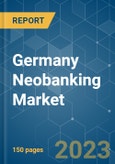The growth of fintech in Germany didn’t slow down due to the COVID-19 pandemic but may have even boosted it. Investors pumped almost 3 times as much money into fintech based in Germany compared to 2020. Increasing adoption of mobile banking platforms and fully digital banking experience contribute significantly to the market growth. The German fintech sector breaks the 900 mark for the first time with 946 start-ups. Investment start-ups showed the strongest growth of all top fintech categories.
N26 is the first Neobank founded in Germany, and it is one of the largest European fintech companies. It leverages AI to organize a user’s expenses by category and make it easier to track spending. N26 takes an average of 170,000 new customers a month.
Germany Neobanking Market Trends
Rising Investment in Fintech in Germany Driving the Market
The German fintech market grew by approximately 120% over the last 7 years. Germany currently has around 950 active start-ups in the fintech sector. 28% are in Berlin, while 11% are based in Frankfurt, despite Frankfurt being the country’s financial hub. Berlin gained popularity as a fintech hub. In 2020, Berlin fintech start-ups received a whopping USD 360 million in financing, which amounted to 64% of total investments in the German sector. Bavaria comes in as a far second at USD 130 million, 24% of total investment.Since 2018, fintech has made up 10% of all new start-ups in Germany, and the sector has become the second-greatest start-up activity in the country’s start-up ecosystem after information and communication technology. The innovative technologies and disruptive business models are removing market entry and expansion barriers, with German FinTechs looking to expand beyond Germany and international FinTechs also entering the German market. Almost three-quarters of foreign FinTechs are active in the banking and lending, payments, and enabling processes and technology segments.
Growing Penetration of Smartphones and Increasing Digitalization Boosted the Neobanking Market.
Digitalization is spreading across all industries, particularly financial transactions, and has expanded to the banking industry. Mobile payments or payments made through portable electronic devices, like a cell phone, a smartwatch, or a tablet, are an alternative to using cash, checks, or physical debit and credit cards.Total transaction value in the Digital Payments segment crossed USD 200 billion in 2021 and growing at a significant rate, the country has had the highest number of digital commerce users within Europe in 2020. As mobile payment solutions become increasingly widespread and integrated within social media platforms, Germany is expected to see a specifically high increase in mobile POS payments.
Germany Neobanking Market Competitor Analysis
The report covers major players operating in the German neobanking market. In terms of market share, few of the major players currently dominate the market. However, with technological advancement and service innovation, domestic to international companies are increasing their market presence by securing new contracts and tapping new markets. It has major players, including N26, Fidor Bank, Bunq and Vivid, etc.Additional Benefits:
- The market estimate (ME) sheet in Excel format
- 3 months of analyst support
Table of Contents
Companies Mentioned (Partial List)
A selection of companies mentioned in this report includes, but is not limited to:
- N26
- Insha
- Fidor Bank
- Penta
- Soldo
- Bunq
- Vivid
- Nuri
- Curve
- Tomorrow
- Wise
- Monese
- Revolut
Methodology

LOADING...








